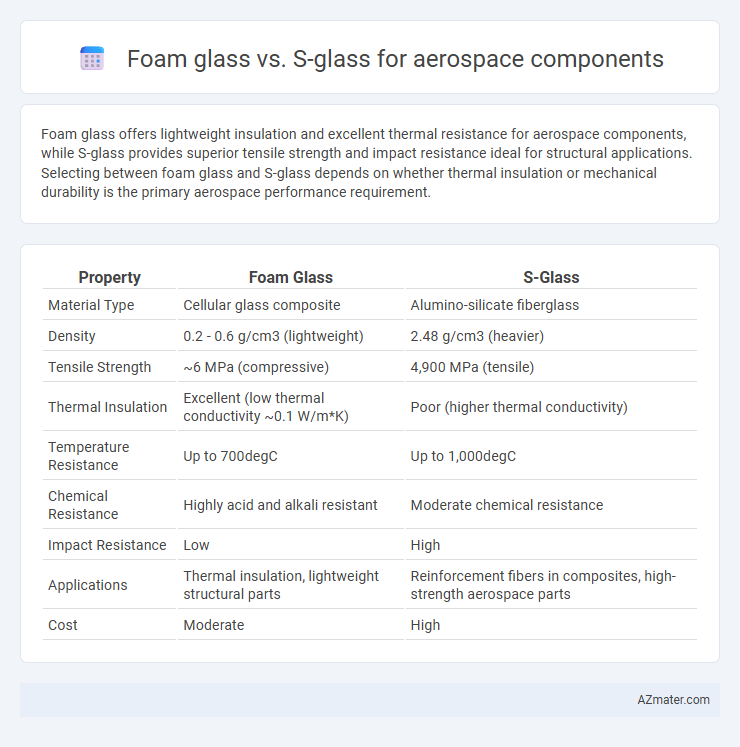Foam glass offers lightweight insulation and excellent thermal resistance for aerospace components, while S-glass provides superior tensile strength and impact resistance ideal for structural applications. Selecting between foam glass and S-glass depends on whether thermal insulation or mechanical durability is the primary aerospace performance requirement.
Table of Comparison
| Property | Foam Glass | S-Glass |
|---|---|---|
| Material Type | Cellular glass composite | Alumino-silicate fiberglass |
| Density | 0.2 - 0.6 g/cm3 (lightweight) | 2.48 g/cm3 (heavier) |
| Tensile Strength | ~6 MPa (compressive) | 4,900 MPa (tensile) |
| Thermal Insulation | Excellent (low thermal conductivity ~0.1 W/m*K) | Poor (higher thermal conductivity) |
| Temperature Resistance | Up to 700degC | Up to 1,000degC |
| Chemical Resistance | Highly acid and alkali resistant | Moderate chemical resistance |
| Impact Resistance | Low | High |
| Applications | Thermal insulation, lightweight structural parts | Reinforcement fibers in composites, high-strength aerospace parts |
| Cost | Moderate | High |
Introduction to Aerospace Composite Materials
Foam glass and S-glass serve distinct roles in aerospace composite materials due to their unique properties and applications. Foam glass is a lightweight, insulating, and fire-resistant material primarily used for thermal management and structural support in aerospace components. S-glass, a high-strength fiberglass variant, offers superior tensile strength and impact resistance, making it ideal for load-bearing structures and reinforcement in aerospace composites.
Overview of Foam Glass and S-Glass
Foam glass is a lightweight, high-strength material made from recycled glass, known for its excellent thermal insulation, low density, and corrosion resistance, making it suitable for aerospace applications requiring thermal management. S-glass, a high-performance fiberglass variant, offers superior tensile strength, high stiffness, and excellent impact resistance, commonly used in aerospace components where strength-to-weight ratio is critical. Both materials provide unique advantages: foam glass excels in insulating and lightweight structural roles, while S-glass is preferred for load-bearing parts demanding enhanced mechanical performance.
Material Properties of Foam Glass
Foam glass offers exceptional thermal insulation, low density, and excellent compressive strength, making it ideal for aerospace applications where weight reduction and thermal management are critical. Its closed-cell structure provides high resistance to moisture, fire, and chemical corrosion, ensuring durability in harsh aerospace environments. Compared to S-glass, foam glass is more effective in preventing thermal conductivity while maintaining structural integrity under extreme conditions.
Key Characteristics of S-Glass
S-Glass, a high-strength fiberglass variant, offers exceptional tensile strength and superior stiffness compared to conventional E-glass, making it ideal for aerospace components requiring lightweight durability. Its enhanced thermal resistance and excellent impact resistance improve component longevity under stressful conditions. Foam glass, while beneficial for insulation due to its lightweight and thermal properties, lacks the mechanical strength and resilience essential for structural aerospace applications.
Comparative Mechanical Strength
Foam glass exhibits lower tensile and compressive strength compared to S-glass, which provides superior mechanical performance with tensile strength reaching up to 4,900 MPa. S-glass fibers offer higher impact resistance and fatigue durability, making them ideal for aerospace components subjected to cyclic and high-load conditions. The lightweight, insulating properties of foam glass are beneficial but structurally inferior to the high-strength, silica-alumina based S-glass composites used in advanced aerospace applications.
Thermal and Chemical Resistance Analysis
Foam glass exhibits superior thermal insulation with low thermal conductivity, maintaining stability up to 650degC, making it ideal for aerospace components exposed to extreme temperature fluctuations. S-glass offers exceptional chemical resistance and mechanical strength, withstanding harsh aerospace environments including exposure to acids and alkalis without degradation. Comparative analysis highlights foam glass's advantage in thermal resistance, while S-glass provides enhanced chemical durability, guiding material selection based on specific aerospace application requirements.
Weight Considerations and Density Comparison
Foam glass offers significantly lower density, typically around 0.2 to 0.4 g/cm3, compared to S-glass fibers, which generally range between 2.5 to 2.6 g/cm3, making foam glass an excellent lightweight material for aerospace components requiring thermal insulation and structural support. S-glass provides superior tensile strength and impact resistance essential for load-bearing aerospace applications but at a higher weight penalty due to its density. The choice between foam glass and S-glass depends on balancing weight reduction with mechanical performance requirements in aerospace design.
Manufacturing and Processing Methods
Foam glass is produced through a high-temperature foaming process that creates a lightweight, highly insulating material, suitable for thermal protection in aerospace components but requiring careful control of temperature and foaming agents during manufacturing. S-glass fibers are manufactured via a continuous filament process involving melting high-purity raw materials and drawing fibers that offer exceptional strength and heat resistance, ideal for composite reinforcements in aerospace structures. Processing S-glass involves precise control of fiber diameter and surface treatment to enhance resin bonding, while foam glass manufacturing emphasizes uniform cell structure and density to ensure consistent performance in aerospace applications.
Cost-Effectiveness in Aerospace Applications
Foam glass offers superior cost-effectiveness for aerospace components by providing lightweight thermal insulation at a lower material and manufacturing cost compared to S-glass fibers. S-glass, while exhibiting higher tensile strength and impact resistance, incurs greater expenses due to complex production processes and raw material costs. Selecting foam glass can optimize budget constraints without substantially compromising performance in non-structural aerospace applications.
Suitability and Recommendations for Aerospace Components
Foam glass offers exceptional thermal insulation and chemical resistance, making it suitable for aerospace components requiring lightweight and non-combustible materials; however, its brittleness limits its use under high mechanical stress. S-glass, a high-strength alumino-silicate fiber, provides superior tensile strength and impact resistance, ideal for load-bearing aerospace structures exposed to dynamic stress and vibration. For aerospace applications emphasizing structural integrity and durability, S-glass composites are recommended, while foam glass is better suited for thermal insulation and non-load-bearing components.

Infographic: Foam glass vs S-glass for Aerospace component
 azmater.com
azmater.com